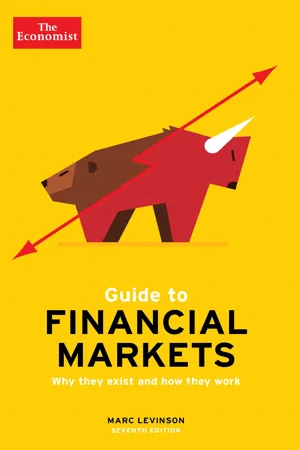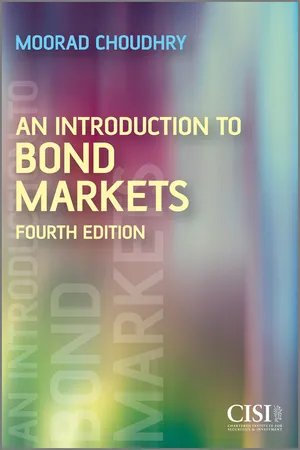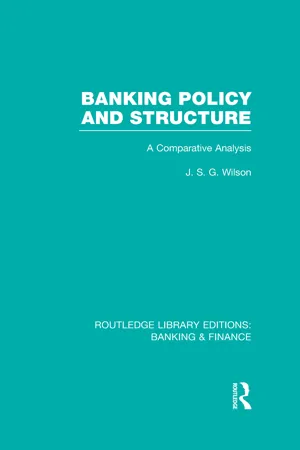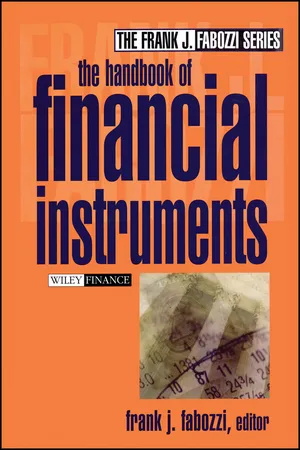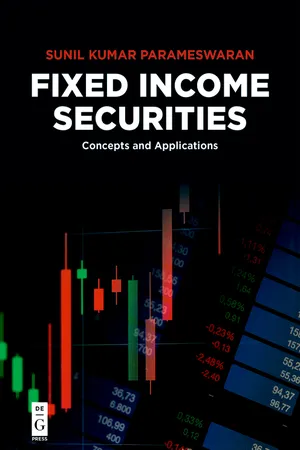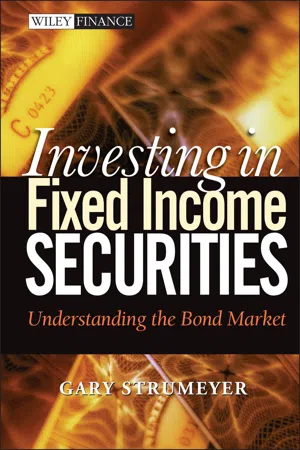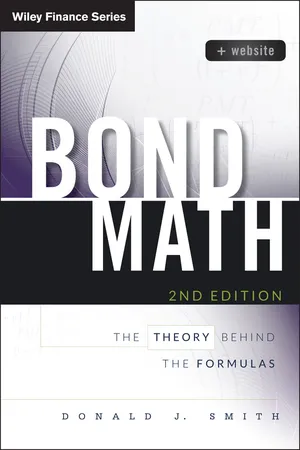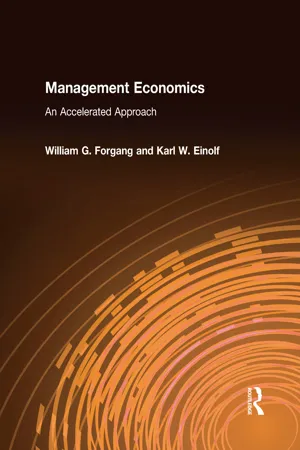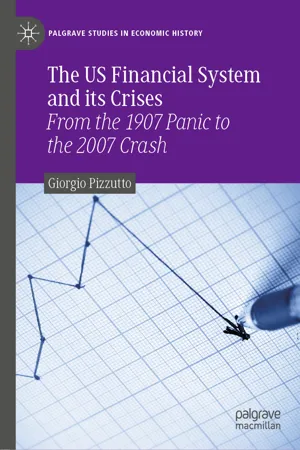Economics
Money Market
The money market refers to the financial marketplace where short-term borrowing and lending of funds occur. It involves the buying and selling of short-term debt securities, such as Treasury bills, commercial paper, and certificates of deposit. The money market plays a crucial role in providing liquidity to financial institutions and facilitating the implementation of monetary policy by central banks.
Written by Perlego with AI-assistance
Related key terms
12 Key excerpts on "Money Market"
- eBook - ePub
The Economist Guide To Financial Markets 7th Edition
Why they exist and how they work
- Marc Levinson(Author)
- 2018(Publication Date)
- Economist Books(Publisher)
3
Money Markets
THE TERM “Money Market” refers to the network of corporations, financial institutions, investors and governments which deal with the flow of short-term capital. When a business needs cash for a couple of months until a big payment arrives, or when a bank wants to invest money that depositors may withdraw at any moment, or when a government tries to meet its payroll in the face of big seasonal fluctuations in tax receipts, the short-term liquidity transactions occur in the Money Market.The Money Markets have expanded significantly in recent years as a result of the general outflow of money from the banking industry, a process referred to as disintermediation. Until the start of the 1980s, financial markets in almost all countries were centred on commercial banks. Savers and investors kept most of their assets on deposit with banks, either as short-term demand deposits, such as cheque-writing accounts, paying little or no interest, or in the form of certificates of deposit that tied up the money for years. Drawing on this reliable supply of low-cost money, banks were the main source of credit for both businesses and consumers.Financial deregulation and the ease of moving money electronically caused banks to lose market share in both deposit gathering and lending. This trend has been encouraged by legislation, such as the Monetary Control Act of 1980 in the United States, which allowed market forces rather than regulators to determine interest rates. Investors can place their money on deposit with investment companies that offer competitive interest rates without requiring a long-term commitment. Many borrowers can sell short-term debt to the same sorts of entities, also at competitive rates, rather than negotiating loans from bankers. The Money Markets are the mechanism that brings these borrowers and investors together without the comparatively costly intermediation of banks. They make it possible for borrowers to meet short-run liquidity needs and deal with irregular cash flows without resorting to more costly means of raising money. - eBook - ePub
- Moorad Choudhry(Author)
- 2010(Publication Date)
- Wiley(Publisher)
Chapter 5THE Money MarketSPart of the global debt capital markets, the Money Markets are a separate market in their own right. Money Market securities are defined as debt instruments with an original maturity of less than 1 year, although it is common to find that the maturity profile of banks’ Money Market desks runs out to 2 years.Money Markets exist in every market economy, which is practically every country in the world. They are often the first element of a developing capital market. In every case they are comprised of securities with maturities of up to 12 months. Money Market debt is an important part of the global capital markets, and facilitates the smooth running of the banking industry as well as providing working capital for industrial and commercial corporate institutions. The market provides users with a wide range of opportunities and funding possibilities, and the market is characterised by the diverse range of products that can be traded within it. Money Market instruments allow issuers, including financial organisations and corporates, to raise funds for short-term periods at relatively low interest rates. These issuers include sovereign governments, who issue Treasury bills, corporates issuing commercial paper and banks issuing bills and certificates of deposit. At the same time, investors are attracted to the market because the instruments are highly liquid and carry relatively low credit risk. The Treasury bill market in any country is that country’s lowest-risk instrument, and consequently carries the lowest yield of any debt instrument. Indeed, the first market that develops in any country is usually the Treasury bill market. Investors in the Money Market include banks, local authorities, corporations, Money Market investment funds and mutual funds, and individuals.In addition to cash instruments, the Money Markets also consist of a wide range of exchange-traded and over-the-counter off-balance sheet derivative instruments. These instruments are used mainly to establish future borrowing and lending rates, and to hedge or change existing interest-rate exposure. This activity is carried out by both banks, central banks and corporates. The main derivatives are short-term interest-rate futures, forward-rate agreements and short-dated interest-rate swaps, such as overnight index swaps. - eBook - ePub
An Introduction to Banking
Liquidity Risk and Asset-Liability Management
- Moorad Choudhry(Author)
- 2011(Publication Date)
- Wiley(Publisher)
Chapter 2 THE Money MarketSP art of the global debt capital markets, the Money Markets are a separate market in their own right. Money Market securities are defined as debt instruments with an original maturity of less than 1 year, although it is common to find that the maturity profile of banks’ Money Market desks runs out to 2 years.Money Markets exist in every market economy, which is practically every country in the world. They are often the first element of a developing capital market. In every case they are comprised of securities with maturities of up to 12 months. Money Market debt is an important part of global capital markets, and facilitates the smooth running of the banking industry as well as providing working capital for industrial and commercial corporate institutions. The market provides users with a wide range of opportunities and funding possibilities, and the market is characterized by the diverse range of products that can be traded within it. Money Market instruments allow issuers, including financial organizations and corporates, to raise funds for short-term periods at relatively low interest rates. These issuers include sovereign governments, who issue Treasury bills, corporates issuing commercial paper and banks issuing bills and certificates of deposit. At the same time, investors are attracted to the market because the instruments are highly liquid and carry relatively low credit risk. The Treasury bill market in any country is that country’s lowest risk instrument, and consequently carries the lowest yield of any debt instrument. Indeed, the first market that develops in any country is usually the Treasury bill market. Investors in the Money Market include banks, local authorities, corporations, Money Market investment funds and mutual funds, and individuals.In addition to cash instruments, the Money Markets also consist of a wide range of exchange-traded and over-the-counter off-balance-sheet derivative instruments. These instruments are used mainly to establish future borrowing and lending rates, and to hedge or change existing interest rate exposure. This activity is carried out by both banks, central banks and corporates. The main derivatives are short-term interest rate futures, forward rate agreements and short-dated interest rate swaps, such as overnight index swaps. - Maureen Burton, Reynold F. Nesiba, Bruce Brown(Authors)
- 2015(Publication Date)
- Routledge(Publisher)
Money Market mutual funds (MMMFs).Money Market
The market for financial assets with an original maturity of less than one year.Money Market Mutual Funds (MMMFs)
Short-term investment pools that use the proceeds they raise from selling shares to invest in various Money Market instruments.Money Market Characteristics, Benefits, and Participants
Despite their name, Money Markets are not used for trading currencies or the components of M1, our most narrow measure of money. Currencies are traded on foreign exchange markets as described in Chapter 8 . Similarly, none of the instruments in M1 (currency in the hands of the public, checkable deposits, and travelers’ checks) are traded in Money Markets. However, most Money Market instruments are highly liquid assets that could be classified as near monies and hence the name is not completely misused.The major Money Market instruments include fed funds, negotiable certificates of deposit (CDs), Treasury bills, commercial paper, Eurodollars, repurchase agreements, and Money Market mutual fund deposits. Although there are as many different types of Money Markets as there are instruments, people often refer to these markets in the singular, as a Money Market. This is because Money Market instruments share many characteristics. First, they are issued in large denominations, usually of $1 million or more. This feature, along with their absence of reserve requirements and lower regulatory burdens when compared to checkable deposits at depository institutions, makes Money Markets an efficient place for raising and storing short-term funds. The large denominations also limit their use primarily to institutional investors. Large institutions that are wholesale borrowers and lenders in the Money Market include commercial banks and savings associations, governments and government-sponsored enterprises (GSEs), the Federal Reserve, corporations and finance companies, pension funds and insurance companies, and securities brokers and dealers. With the exception of Money Market mutual fund shares, Money Market instruments are rarely used in retail markets where most individual investors purchase securities. Second, Money Market instruments have short maturities, typically less than three months, but ranging from one day to one year. Third, Money Market instruments are characterized by low liquidity and default risk. Short maturities and active resale markets for most instruments provide considerable insulation from liquidity risk. (Exhibit 11-1 shows that only repurchase agreements and non-negotiable Eurodollar time deposits lack secondary markets.) Their sale by some of the most creditworthy borrowers, namely the federal government and large financial and nonfinancial corporations, lowers an investor’s exposure to default risk. Investor risk exposure is further reduced by some commercial paper and bankers’ acceptance issuers contracting with banks to provide liquidity through credit lines and protection against default through payment guarantees. However, it should be noted that the liquidity and credit quality of some Money Market instruments was called into question in the financial crisis of 2008, and like other financial markets, this market has been profoundly affected by the crisis. Fourth and finally, unlike commodities or stocks that often trade on specific exchanges, the Money Market does not occupy one particular geographic location or trading floor. The market tends to be centered in New York City, but it consists of borrowers and lenders as well as brokers and dealers linked by telecommunications throughout the nation and increasingly around the world. Exhibit 11-1- eBook - ePub
Banking Policy and Structure (RLE Banking & Finance)
A Comparative Analysis
- J Wilson(Author)
- 2012(Publication Date)
- Routledge(Publisher)
3 it has been possible to encourage private enterprise itself to supply the desired facilities, while at other times (e.g., in Australia) it was private enterprise that forced the pace and the authorities were ultimately obliged to recognise the existence of a market and to provide it with the lender-of-last-resort facilities without which such a market cannot approach its full potential.Defined in a narrow sense, the term ‘Money Market’ can be applied to that group of related markets which deals in assets of relative liquidity – such as call money, federal funds, Treasury bills or notes, bills of exchange (or other ‘commercial paper’), and short-dated government bonds. In some centres, the term has been applied very narrowly indeed, as used to be the case in London where the Money Market was regarded as deriving primarily from the market relationships between the discount houses and the commercial banks. Nevertheless, such an emphasis where it occurs must not blind us to the fact that the term is not infrequently also applied in a wider and looser context. In its broader connotations, the term encompasses the whole complex of financial institutions, which in varying degrees act together to satisfy the monetary needs of a community and, sometimes, such institutions are scattered spatially over a wide area.Whatever type of definition one attempts, money-market structure shows a wide diversity of form and it would serve no useful purpose to impose a classification by categories. In this field, probably more than in any other, it is extremely difficult to find any precise lines of division between one ‘type’ and another. Over recent years, it is true, economists have increasingly attempted to draw a distinction between ‘developed'and ‘undeveloped’ Money Markets, but the forms of organisation are so various that the line of demarcation becomes decidedly blurred. It is surely all a matter of degree. Yet some ‘standard of reference’ there must be. - eBook - ePub
- Frank J. Fabozzi, Frank J. Fabozzi(Authors)
- 2018(Publication Date)
- Wiley(Publisher)
Chapter 6Money Market Instruments
Frank J. Fabozzi, Ph.D., CFAAdjunct Professor of Finance School of Management Yale UniversitySteven V. Mann, Ph.D.Professor of Finance The Moore School of Business University of South CarolinaMoorad ChoudhrySenior Fellow Centre for Mathematical Trading and Finance City University Business SchoolThe Money Market is the market for financial instruments that have a maturity of one year or less. The financial instruments traded in this market include securities issued by the U.S. Department of the Treasury (specifically, Treasury bills), U.S. federal agency securities (discount note and various “bill” products), depository institutions (negotiable certificates of deposit, federal funds, and bankers acceptances), insurance companies (funding agreements), commercial paper, medium-term notes, repurchase agreements, short-term municipal securities, short-term mortgage-backed securities, and asset-backed securities. In this chapter we cover all but the last three financial instruments.U.S. TREASURY BILLS
The U.S. Treasury is the largest single borrower in the world. Treasury bills are short-term discount instruments with original maturities of less than one year. All Treasury securities are backed by the full faith and credit of the U.S. government. This fact, combined with their volume (in terms of dollars outstanding) and liquidity, afford Treasury bills a central place in the Money Market. Indeed, interest rates on Treasury bills serve as benchmark short-term rates throughout the U.S. economy as well as in international Money Markets.Treasury bills are issued at a discount to par value, have no coupon rate, and mature at par value. The Treasury currently issues on a regular basis bills with original maturities of 4 weeks, 13 weeks (3 months) and 26 weeks (6 months), as well as cash-management bills with various maturities.Cash management bills - eBook - ePub
Fixed Income Securities
Concepts and Applications
- Sunil Kumar Parameswaran(Author)
- 2019(Publication Date)
- De Gruyter(Publisher)
6 The Money MarketThe market for capital is divided into the Money Market and the capital market. Medium-term and long-term bonds and equity securities are issued in the capital market. This market is an arena where parties raise funds to make long-term investments. Thus if a manufacturing company wishes to set up a new factory, or a company seeks to borrow to construct a new building for its headquarters, it usually approaches the capital market. However, in practice, funds may also be required for managing liquidity imbalances. Take the case of the federal government. It gets its revenues primarily by way of taxes. However, tax receipts tend to be lumpy, and inflows do not occur throughout the year on a uniform basis. On the other hand, expenditures are usually incurred on a daily basis. Consequently, even if the federal government has a surplus budget for the year as a whole, which is usually not the case, during most of the year it will have a deficit. In such a situation, it has no choice but to borrow for short periods and hence approaches the Money Market. Similarly, take the case of a company that needs short-term capital for meeting revenue expenditure. Such a company may be profitable for the year, but may often have a cash deficit and require short-term capital for meeting expenditures. In such cases, it too approaches the Money Market. Thus, both government and business entities will approach the Money Market when they are in need of short-term funds.What motivates lenders to lend in such markets? For most business and government entities, cash inflows and outflows are not perfectly synchronized, and consequently there is a short-term deficit or surplus. While entities with a deficit have no option but to borrow, parties with a surplus seek to lend because money is a perishable asset.If cash is kept idle, there is an opportunity cost in terms of interest foregone. When large amounts of funds are involved, the lost income can be substantial. Take for instance the case of an institution that has $100 million available. If we assume that the interest rate is 3% per annum and the year consists of 360 days, which is the assumption in the U.S. Money Market, the loss if the funds are kept idle for six days is - eBook - ePub
Investing in Fixed Income Securities
Understanding the Bond Market
- Gary Strumeyer(Author)
- 2012(Publication Date)
- Wiley(Publisher)
Chapter 8
Money Market Instruments
An individual investor seeking to maximize the return on his short-term fixed income assets, or a cash manager looking to get the biggest bang for her buck on the firm’s liquid assets, must understand the Money Market (MM) with its unique characteristics and distinctive formulaic calculations. First, you should learn about the myriad MM products available, as well as the players in this unique market. You must understand the products’ characteristics and risk/reward trade-offs. Then, you need to determine the time horizon or duration of the assets purchased. Finally, you must compare the yields on these different products to assess whether you are being rewarded for any additional risks (credit and market) undertaken.The Money Market involves the borrowing and lending of money for periods of a year and less. Massive sums of capital can be transferred rapidly and efficiently from one economic unit (corporations, municipalities, banks, etc.) to another for relatively short periods of time. Institutions with short-term borrowing needs can meet these needs by maintaining access to the Money Market and raising funds when required. In the same way, holders of excess cash can maximize their returns by investing in Money Market securities.Money Market securities are thus debt instruments characterized by short-term maturities ranging from overnight to one year. Money Market securities are typically liquid, and possess relatively high credit quality and low interest rate risk. Trades in Money Markets are generally quite large (trades in the billions of dollars are common). Active secondary markets allow most MM securities to be sold prior to maturity if a need for cash emerges.These instruments are influenced by Federal Reserve policy and activity more than any other sector of the fixed income market. Utilizing the Money Market allows investors to enhance returns on cash reserves, while at the same time maintaining liquidity and preserving capital through high-quality investments. Investors managing large cash balances through the utilization of Money Market mutual funds can in effect cut out the middleman and purchase short-term securities directly in the Money Market. - eBook - ePub
Bond Math
The Theory Behind the Formulas
- Donald J. Smith(Author)
- 2014(Publication Date)
- Bloomberg Press(Publisher)
CHAPTER 1 Money Market Interest RatesAn interest rate is a summary statistic about the cash flows on a debt security such as a loan or a bond. As a statistic, it is a number that we calculate. An objective of this chapter is to demonstrate that there are many ways to do this calculation. Like many statistics, an interest rate can be deceiving and misleading. Nevertheless, we need interest rates to make financial decisions about borrowing and lending money and about buying and selling securities. To avoid being deceived or misled, we need to understand how interest rates are calculated.It is useful to divide the world of debt securities into short-term Money Markets and long-term bond markets. The former is the home of Money Market instruments such as Treasury bills, commercial paper, bankers acceptances, bank certificates of deposit, and overnight and term sale-repurchase agreements (called “repos”). The latter is where we find coupon-bearing notes and bonds that are issued by the Treasury, corporations, federal agencies, and municipalities. The key reference interest rate in the U.S. Money Market is 3-month LIBOR (the London Interbank offer rate); the benchmark bond yield is on 10-year Treasuries.This chapter is on Money Market interest rates. Although the Money Market usually is defined as securities maturing in one year or less, much of the activity is in short-term instruments, from overnight out to six months. The typical motivation for both issuers and investors is cash management arising from the mismatch in the timing of revenues and expenses. Therefore, primary investor concerns are liquidity and safety. The instruments themselves are straightforward and entail just two cash flows, the purchase price and a known redemption amount at maturity.Let’s start with a practical Money Market investment problem. A fund manager has about $1 million to invest and needs to choose between two 6-month securities: (1) commercial paper (CP) quoted at 3.80% and (2) a bank certificate of deposit (CD) quoted at 3.90%. Assuming that the credit risks are the same and any differences in liquidity and taxation are immaterial, which investment offers the better rate of return, the CP at 3.80% or the CD at 3.90%? To the uninitiated, this must seem like a trick question—surely, 3.90% is higher than 3.80%. If we are correct in our assessment that the risks are the same, the CD appears to pick up an extra 10 basis points. The initiated know that first it is time for a bit of bond math. - eBook - ePub
Management Economics: An Accelerated Approach
An Accelerated Approach
- William G. Forgang, Karl W. Einolf(Authors)
- 2015(Publication Date)
- Routledge(Publisher)
3Money and the Financial Markets
The previous chapter develops a model of the economy that explains short-term macroeconomic fluctuations through an income and expenditures approach. The prior chapter does not consider (1) the role of money in facilitating transactions in the goods or resource markets, (2) interest rates, monetary policy, and economic fluctuations, (3) the process by which funds flow from savers to investors, or (4) the mechanics of financing government budgetary deficits. This chapter fills the gaps.Learning ObjectivesThe successful reader understands:• The structure and operations of the money and financial systems and the role of money and interest rates in the economy• Monetary policy and its effects on a firm’s operating environment• The money and financial system as environments within which business and personal investment occurAn understanding of how money and credit interact with real economic activity is fundamental to management responsibilities. Business decisions dependent upon money and credit conditions include the management of a firm’s cash position, extending and receiving credit, establishing the appropriate debt-to-equity ratio, and planning for the firm’s long-term physical and financial capital needs. However, the importance of money and credit extends well beyond financial management decisions. The demand for many products is sensitive to the price and availability of credit, and decisions in production, procurement, hiring, and inventory control are made within the monetary and financial environments. Further, personal financial planning and investment decisions are made within these environments and include the timing of buying goods on credit, choosing a fixed-or variable-rate mortgage, selecting stocks, and choosing the maturity of financial investments.Two sets of issues are covered in this chapter. The flow of funds section of this chapter examines the institutions and markets that facilitate the transmission of foreign and domestic savings to companies for investment in plant and equipment, to government to finance public debt, and to households for purchases of homes, cars, and other durable products. The second section of this chapter examines the role of money in the economy, monetary policy, and interest rates. - eBook - ePub
The US Financial System and its Crises
From the 1907 Panic to the 2007 Crash
- Giorgio Pizzutto(Author)
- 2019(Publication Date)
- Palgrave Macmillan(Publisher)
© The Author(s) 2019 Giorgio Pizzutto The US Financial System and its Crises Palgrave Studies in Economic History https://doi.org/10.1007/978-3-030-14489-0_8Begin AbstractEnd Abstract8. The Money Market, the Collateral Market, and the Crisis of 2007–2008
The financial crisis that began in August 2007 marked the beginning of a dramatic period for the US financial system, one that would continue for more than a year up to the failure of Lehman Brothers and beyond. The crisis took place in a segment of the financial system that links the Money Market and brief-term credit to long-term credit in the form of securitized mortgages. It is thus partially extraneous to the commercial banking system.Money Markets and capital markets are linked via Money Market funds and the vehicles created by the banking system to externalize the securitization process. Money Market funds handle wholesale liquidity that cannot be placed in bank deposits. They hold liquidity generated by large non-financial corporations, central banks , investment funds, and generally all financial intermediaries. These parties cannot put their liquidity in the bank for the simple reason that bank deposits are insured only up to a certain threshold. They thus seek a counterparty that can ensure this liquidity will retain its value by means of alternative mechanisms to retail deposits. Money Market funds have never enjoyed government insurance—except during the 2008 crisis—and must thus choose an investment strategy that will reassure their depositors/financers, whose primary objective is not so much high yield but rather the stability of their capital. The sums they have on deposit must be immediately available without the risk of losing value. Institutional Money Market funds handle the liquidity of financial intermediaries and financial and non-financial corporations and constitute the most important component of Money Market funds. Retail funds handle the invested capital of families; the values here are much lower than in Money Market funds. The funds provide a higher yield than could be obtained with a bank account; they pledge to keep a stable quotation, investing primarily not only in short-term government securities (e.g., US Treasury bills and commercial paper) but also in corporate bonds (prime funds). Prime Money Market funds invest in short-term assets issued by commercial banks and investment banks - eBook - ePub
- W. Charles Sawyer, Richard L. Sprinkle(Authors)
- 2020(Publication Date)
- Routledge(Publisher)
2 Internationally, this definition of the money supply is known as narrow money.Other definitions of money are possible. There are a number of financial assets that are referred to as near monies that can be used as money in many circumstances. Near monies are highly liquid financial assets such as savings accounts, time deposits, and short-term government securities. In many cases, these assets cannot be spent as easily as can currency or a demand deposit at a local bank. An example of a near money is an account with a Money Market mutual fund. In the U.S., this is a common form of near money. In other countries, where this form of near money is less common, a large amount of near money is held in the form of time deposits. For the most part, near monies do not function as a medium of exchange but they can be readily converted into currency or demand deposits. For the U.S., M1 plus Money Market mutual funds and time deposits constitutes M2. In an international context, the term for M2 is called broad money.Ultimately, the supply of money within a country is the result of a process that we need to describe. In order to do this we will need to look at an important part of the money supply known as the monetary base (B). The monetary base (B) is composed of cash in the hands of theBOX 15.1WHAT IS THE SUPPLY OF MONEY?Even though the public can hold money for a variety of reasons, the supply of money that is relevant for the purposes of economic policy is a measure of money that will be used for economic transactions within a given period of time, such as a year. Unfortunately, in most countries such a perfect measure of the money supply does not exist. For example, in the U.S. neither M1 nor M2 is identical to the supply of money the public uses for short-run economic transactions. The primary reason why this is true is related to the existence of Money Market mutual funds. These funds can be used for transactions, as each account has limited check-writing capabilities. In addition, these accounts are also widely used as a parking place for funds between the purchase and sale of equities, bonds, and other long-term financial assets. As a result, M1 understates the amount of money that the public could use for short-run economic transactions, and M2 overstates this same amount. In this case, the central bank of the U.S. cannot know with certainty what the amount of money is that the public intends to use for short-run economic activities. To a greater or lesser extent, every country has this problem of defining what the relevant supply of money is. In the discussion that follows, we assume that there is a relevant supply of money under the central bank’s control. However, one should keep in mind that the supply of money in an economy is not as clear-cut in most cases as central bankers or those following the state of the economy might like.
Index pages curate the most relevant extracts from our library of academic textbooks. They’ve been created using an in-house natural language model (NLM), each adding context and meaning to key research topics.
